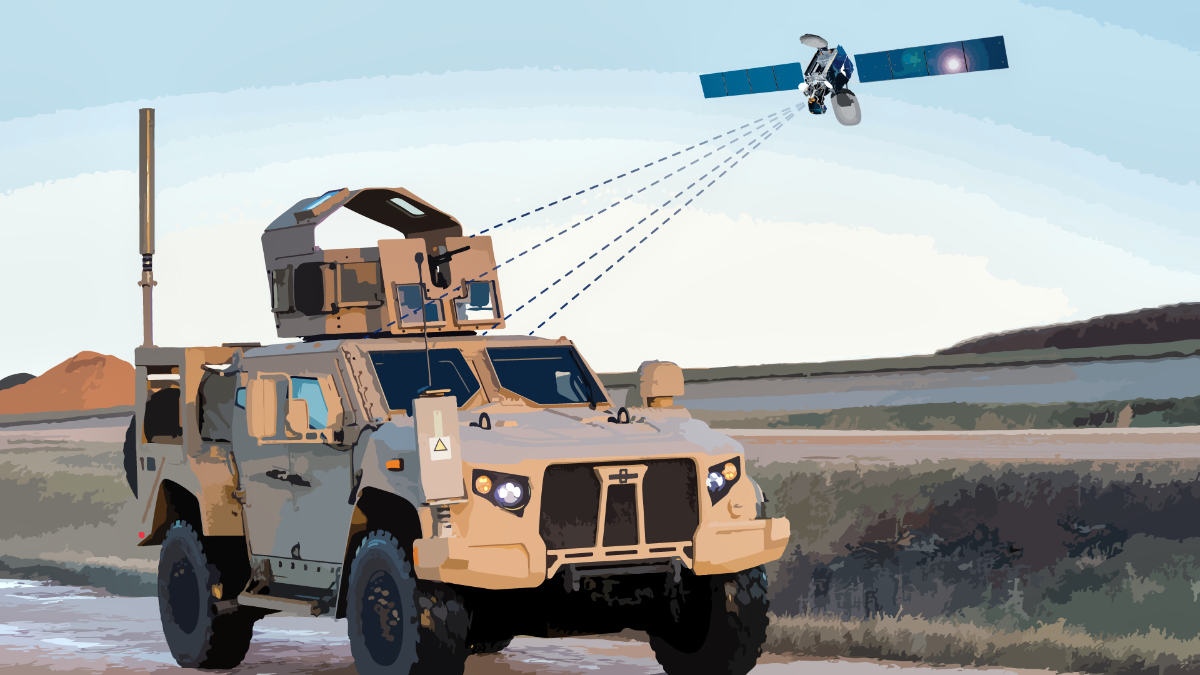Supporting Communications-on-the-Move (COTM) is an intricate and crucial process, but when attempting to maintain communications while mounted in an armored vehicle, the challenges multiply.

Using GEO satellites requires a larger antenna. This presents difficulties in mechanically maintaining the antenna’s pointing toward the satellite without interfering with neighboring satellites, all the while simultaneously experiencing enhanced, vehicle dynamics.
In COTM situations, there is a typical misconception that large bumps or hilly terrain present the biggest hardships for a satellite antenna. In actuality, the most challenging condition for the antenna is what is known as a washboard effect. This effect is a larger version of the rumble strips you might encounter on the sides of highways today. Encountering such terrain is disruptive to large antenna performance.
However, terrain is not the only challenge to large vehicle- mounted antennas. Weapons and other equipment on the vehicle all have the potential to block significant portions of the antenna’s view of the sky. The reverse is also true — with limited space, a large antenna has the potential to interfere with the weapons systems, giving the soldier a larger chance of unintentionally taking out their antenna — and their communications.
With limited space and power inherent in a COTM situation, a vehicle must be able to deploy its weapons without sacrificing the ability to maintain communications. Neither the antenna nor the weapons systems should interfere with each other to avoid jeopardizing the crew and the mission.
In 2013, researchers from the U.S. Army sought suggestions from industry around an open-standard system that would enable them to purchase distributed aperture SATCOM antennas, specifically for vehicles in COTM situations. The initiative was called DESSTA. (Distributed and Embedded Standard SATCOM On-The- Move Terminal Architecture). Ultimately, DESSTA failed because of the significant size, weight and power (SWaP) constraints encountered with vehicle integration.
Since 2013, digital signal processing and integrated RF circuit technologies, together with the advent of 5G cellular, millimeter wave and LEO SATCOM antennas have advanced to the point where these constraints can now be solved.
One approach to solving these challenges is to use split array technology to distribute antennas around the vehicle to optimize a COTM situation. This solution allows both
the weapons and communications systems to operate independently and effectively without blocking the view of the sky or the enemy, all while providing a significant increase in integration flexibility.
 Fairwinds Technologies GlobalLink.
Fairwinds Technologies GlobalLink.
By using distributed antenna panels around the vehicle, the antennas coordinate digitally and do not require the same, signal timing references. Also — no longer is there the risk of weapons and comms systems interfering with one another.
Furthermore, the panels can be disguised as armor to blend in with the rest of the vehicle’s armor plates. By moving to a phased array-based system from a dish-based GEO system, support for LEO/MEO/GEO satellite communications is enabled. Finally, using multiple antennas inherently provides resiliency from local interference.
Fairwinds Technologies has developed Global Link to be used as an RF Signal Processing System that enables the routing and management of multiple antennas/beams and modems in addition to providing the ability to distribute antennas around a platform and function as a single terminal. By incorporating distributed panels with Global Link, each of the antennas can operate either as separate antennas or as one combined antenna.
The most challenging aspect encountered when communicating with satellites is reception — the only way to truly increase this capability is through a larger, signal collector. By combining separate, smaller, distributed antennas, a larger collector can be enabled without a single, larger integration challenging footprint.
Significant integration flexibility is enabled by distributing small antennas around the vehicle and away from the weapons systems. From a cost standpoint, four small terminals are far more cost-effective than a single terminal.
Embedded in Global Link are multiple patents pending that are considered key enabling technology as they empower multiple capabilities. This system digitizes and provides Mil-Std 188-164C compliant equalization on up to 800 MHz. of spectrum on each of the terminals that are connected, and routes and switches between modems and antennas to enable multiple, simultaneous satellite communications links. This system essentially provides any connected satellite waveform on any antenna beam or antenna.

This digitization of spectrum could also be leveraged by signal intelligence processing systems that effectively turn any connected antenna or terminals into instant RF sensors. Additional Global Link innovations could rip and replace any existing modems. Also provided is a significant, future-proofing capability, as it is possible to easily add new modems and terminals as they become available, without having to reintegrate the RF cabling within the mobile platform.
Fairwinds is also developing multiple modem APIs that add the capability to monitor, control, and manage modems that are connected to the Global Link.
Currently, Fairwinds already has multiple software API’s available for the Comtech DMD-50, DMD-2050e and CDM-760 modems. This capability is enabled through SNMP interfaces. Fairwinds is currently in development of additional APIs for iDirect modems and is open to considering additional modem support as requested.
While COTM has always been a challenge for the military, innovations such as digital signal processing and integrated RF circuit technologies, as well as 5G cellular millimeter wave and LEO SATCOM antenna, are improving the situation. The new technologies enhance operations on the move by securing communications, the warfighter and the mission.
www.fairwinds-tech.com/products/global-link/

Tim Hillner
Tim Hillner is the Chief Technology Officer and Co-Founder at Fairwinds Technologies where he leads all the strategic technical aspects of the business including new product development, innovative research & development, and pre-sales engineering. Prior to Fairwinds Technologies, he was a C4ISR solutions architect and DoD account manager at Comtech Command & Control Technologies. He also worked at the Army as a Team Lead – Senior Engineer managing multiple tactical wireless telecommunication solutions. He is a graduate of Messiah University and holds a Master of Electrical Engineering, Wireless Communications from Stevens Institute of Technology.


